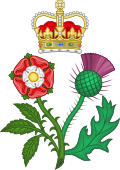Second Stanhope–Sunderland ministry
The second Stanhope–Sunderland ministry (1718–1721) was a continuation of the British Whig government headed by The Earl of Sunderland and The Earl Stanhope.These had taken power in 1717 to form the first Stanhope–Sunderland ministry, and in 1718 they interchanged positions, with Sunderland becoming First Lord of the Treasury.[1] The ministry terminated upon Stanhope's death in February 1721.[2]
StanhopeSunderlandThe Earl of SunderlandThe Earl Stanhopefirst Stanhope–Sunderland ministryFirst Lord of the TreasuryNorthern SecretaryLord ChancellorThe Earl of MacclesfieldLord President of the CouncilThe Duke of KingstonThe Viscount TownshendLord Privy SealThe Duke of KentSouthern SecretaryJames Craggs the YoungerThe Lord CarteretFirst Lord of the AdmiraltyThe Earl of BerkeleyChancellor of the ExchequerJohn AislabieMaster-General of the OrdnanceThe Duke of MarlboroughPaymaster of the ForcesThe Earl of LincolnRobert WalpoleLord Lieutenant of IrelandThe Duke of BoltonThe Duke of GraftonLord StewardThe Duke of ArgyllLord ChamberlainThe Duke of NewcastleSecretary of State for ScotlandThe Duke of RoxburgheGovernment of Great BritainWalpole–Townshend ministryBritish governmentsGreat BritainGodolphin–MarlboroughHarleyTownshendStanhope–Sunderland IWalpole–TownshendWalpoleCarteretBroad Bottom I and IIShort-livedNewcastle IPitt–Devonshire1757 CaretakerPitt–Newcastle (Newcastle II)GrenvilleRockingham IChathamGraftonRockingham IIShelburneFox–North (Portland I)Pitt IUK (GB and Ire)AddingtonPitt IIAll the TalentsPortland IIPercevalLiverpoolCanningGoderichWellington–PeelMelbourne IWellington CaretakerPeel IMelbourne IIPeel IIRussell IWho? Who? (Derby–Disraeli I)AberdeenPalmerston IDerby–Disraeli IIPalmerston IIRussell IIDerby–Disraeli III (Disraeli I)Gladstone IDisraeli IIGladstone IISalisbury IGladstone IIISalisbury IIGladstone IVRoseberySalisbury III and IVBalfourCampbell-BannermanAsquith I–IIIAsquith CoalitionLloyd George I and IIUK (GB and NI)Baldwin IMacDonald IBaldwin IIMacDonald IINational Government INational Government IINational Government IIINational Government IVChamberlain WarChurchill WarChurchill CaretakerAttlee I and IIChurchill IIIMacmillan I and IIDouglas-HomeWilson I and IIWilson III and IVCallaghanThatcher IThatcher IIThatcher IIIMajor IMajor IIBlair IBlair IIBlair IIICameron–Clegg (Cameron I)Cameron II